READERS GUIDE
Discussion Questions:
1. Alois Podhajsky said, “Equestrian art is, perhaps more than any other, closely related to the wisdom of life.” What does he mean by this? Is the relationship between horse and man fundamentally different from the relationship between humans and other animals, or is it similar?
2. The Spanish Riding School of Vienna has survived for five centuries in spite of wars and changes of governments that have toppled many more mighty institutions. What was special about the Spanish Riding School that helped it survive?
3. In The Perfect Horse we see how ideas developed to improve animal breeding contributed to the pseudoscience of eugenics—an early 20th century movement to improve the human race that eventually contributed to the Nazi philosophy of racial purity. Are there any drawbacks to breeding purebred animals? What made people want to apply the theories of animal breeding to humans? Do you think this could ever happen again?
4. Several of the major players in this story had a connection to the Olympic Games. George Patton competed in 1912, Podhajsky in 1936. Reed was an alternate for the 1932 team. How did the Olympic experience shape these men and how did it influence their decisions during the war?
5. George Patton famously said that during peacetime, playing polo was the closest that an officer could get to real combat. Many of World War II’s most brilliant leaders were horsemen, and many believed that eliminating the training on horseback would be an irreparable loss to the Army. What was it about their devotion to horses that made them so successful in war? Does working with animals teach skills that are impossible to learn in any other way?
6. There were surprisingly few events during World War II in which men from opposing sides joined together in a common task. Why did the German horsemen risk treason to join with the Americans? What would have likely happened if the Germans had decided to stay put and wait for the end of the war? Given the circumstances, did everyone involved make the right decision?
7. Critics of Patton have said that he was more concerned about gathering up Lipizzaner horses than with saving human refugees and concentration camp survivors. Given the number of other atrocities going on in late April, 1945, was it worth the sacrifice of men and manpower to safeguard the horses?
8. The bravery and selflessness of Captain Tom Stewart, who followed orders to ride across enemy lines to negotiate the stud farm’s release, seems striking to a modern reader. As the son of a sitting senator, certainly he could have been spared being put into such a dangerous situation. What was it about Tom Stewart’s character that was exceptional? Were the morals and motivations of the World War II’s citizen soldiers different from the way people view their duty and honor today?
9. While the Lipizzaner were mostly returned to their native Austria, Witez was shipped to America, eventually sold off at auction, and never returned to his native Poland. The author, in her research, discovered that the Poles were actively trying to reclaim Witez before he was ever shipped to America, but the Americans were distrustful of the Poles and dismissed their claims to the horse. Should Witez have been returned to Poland or was his rightful place in America?
10. At Hank Reed’s funeral, more than twenty of the men who had served under him came to pay their respects. What was it about Hank Reed’s background, training, or education made his men so devoted to him.? What can we learn about leadership by looking at the lives of the men and women who were part of “The Greatest Generation?”

